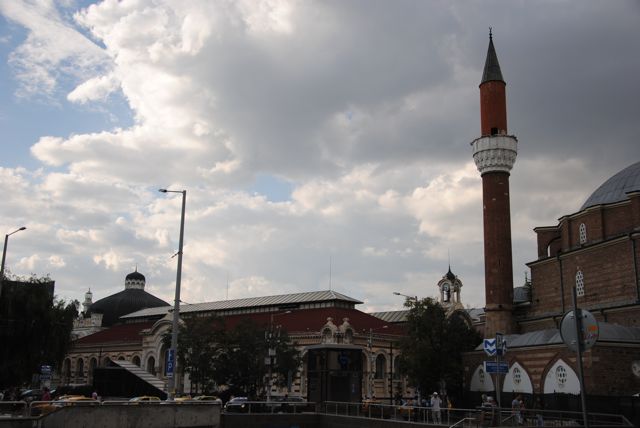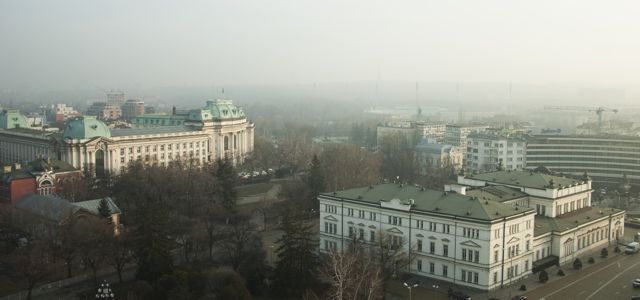Photos: the author
Polina Spartyanova
Sofia is one of the few capitals in Europe that offers visitors "something for everyone" and can satisfy the whims of every pretentious tourist. The city has a rich historical and archaeological heritage that, at the same time, coexists with modern European architecture from the beginning of the previous century as well as with socialist monumental buildings from the totalitarian regime. The capital of Bulgaria is situated at the foot of Vitosha Mountain, the fourth highest mountain in the country, that offers skiing and mountaineering at affordable prices. At the end of a day spent in Sofia, you can visit some of the best Bulgarian restaurants and nightclubs, which every night offer their guests a varied programme and entertainment.
Sofia of the present day is the second oldest European capital after Athens. The history of the Bulgarian capital began during the Neolithic era and the modern archaeological findings prove that, in these places, there were several Neolithic settlements that date back to the year 5000 BC. Later in the 7th century, an ancient Thracian city was established, documented later by the Romans who lived in these lands as "Serdica", as it was inhabited by the ancient tribe "Serdi". When Serdica fell under the influence of the Roman Empire in the 1st century, the city was renamed Ulpia Serdica in honour of Emperor Marcus Ulpius Trajan who allowed its self-governance. The city flourished until the 5th century, during the Roman epoch, but suffered from the invasions of the Huns, Goths and Barbarians during the Migration Period. It revived in the 6th century under the name Triadica, as an important administrative and economic centre of the Byzantine Empire. In 809, the city became part of the Bulgarian state and it was called Sredets. It was last renamed in the early 14th century when the "St. Sofia" church located in the city gained such great fame among the Slavic peoples that the city was renamed "Sofia" from "Sredets". After the Liberation of Bulgaria from Ottoman rule, the city became the capital of the emerging areas in 1879 and has remained so to this day.
 Walking along the central streets of Sofia, you can find preserved archaeological sites from the time of Serdica, which are widely open to visitors at any time of day. Unique archaeological sites of the area are exposed in the underground station in the heart of the city, contributing to the integration of this era in the modern urban environment. Naturally, the majority of the exhibits are displayed in the National Archaeological Museum which is housed in the oldest building in Sofia that functioned as a mosque before the Liberation from Ottoman rule. In fact, after Bulgaria appeared on the map of Europe, all mosques in Sofia suspended their activities, with the exception of the Banya Bashi Mosque in the city centre. It was built by famous Ottoman architect Sinan in the middle of the 14th century and reflects the specifics of the Ottoman architectural ideas of the period. The place where the mosque was built is now known as the Square of Tolerance because one Orthodox Church, one Catholic Church and the largest Sephardic (Spanish-Jewish) synagogue in Europe are at a distance of 200 metres from it. However, the size of the Jewish house of prayer is not the most impressive thing - its magnificent murals catch the eye as soon as the visitor takes his or her eyes off the main room chandelier that weighs nearly two tons and is the largest in Bulgaria.
Walking along the central streets of Sofia, you can find preserved archaeological sites from the time of Serdica, which are widely open to visitors at any time of day. Unique archaeological sites of the area are exposed in the underground station in the heart of the city, contributing to the integration of this era in the modern urban environment. Naturally, the majority of the exhibits are displayed in the National Archaeological Museum which is housed in the oldest building in Sofia that functioned as a mosque before the Liberation from Ottoman rule. In fact, after Bulgaria appeared on the map of Europe, all mosques in Sofia suspended their activities, with the exception of the Banya Bashi Mosque in the city centre. It was built by famous Ottoman architect Sinan in the middle of the 14th century and reflects the specifics of the Ottoman architectural ideas of the period. The place where the mosque was built is now known as the Square of Tolerance because one Orthodox Church, one Catholic Church and the largest Sephardic (Spanish-Jewish) synagogue in Europe are at a distance of 200 metres from it. However, the size of the Jewish house of prayer is not the most impressive thing - its magnificent murals catch the eye as soon as the visitor takes his or her eyes off the main room chandelier that weighs nearly two tons and is the largest in Bulgaria.

According to the Constitution of the Republic of Bulgaria, the country has no official religion, but Orthodox Christianity is stated as the traditional religion of the people, as 59% of the population is determined by it. Therefore, Sofia is dotted with numerous churches and monasteries. The preserved churches of "St. Petka of the Saddlers" and "St. George" are located in the city centre, the first one dating back to the beginning of the 11th century and the latter to the period of the Serdica complex. Both churches are unique in terms of their architecture and partly preserved frescoes, and have been able to survive for centuries, their biggest victory being that over the totalitarian regime in Bulgaria. When the communist dictatorship was established in the country, the religious institutions contradicted its ideology and therefore the value of the religious monuments was not taken seriously. Nevertheless, during the construction of the architectural ensemble Largo, which consists of three buildings in the style of socialist classicism, the Bulgarian and Soviet architects shared the same opinion, namely that the buildings are too precious to be destroyed. Therefore, the Largo in Sofia is one of the few communist architectural complexes that integrate religious institutions. Compared with the architectural projects for institutional buildings in the Eastern Bloc, the Largo in Sofia also boasts the combination of buildings constructed in the style of the aristocratic architecture from the beginning of the 20th century with buildings in the style of the socialist classicism. During the totalitarian regime in Bulgaria, the buildings housed the Bulgarian Communist Party and some national institutions and today the National Assembly, the Council of Ministers and the Presidency.
